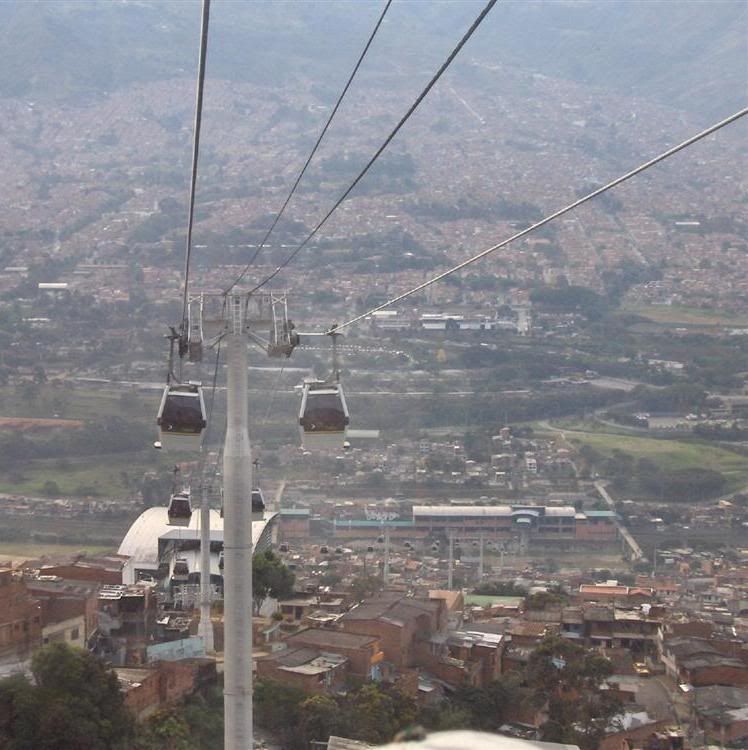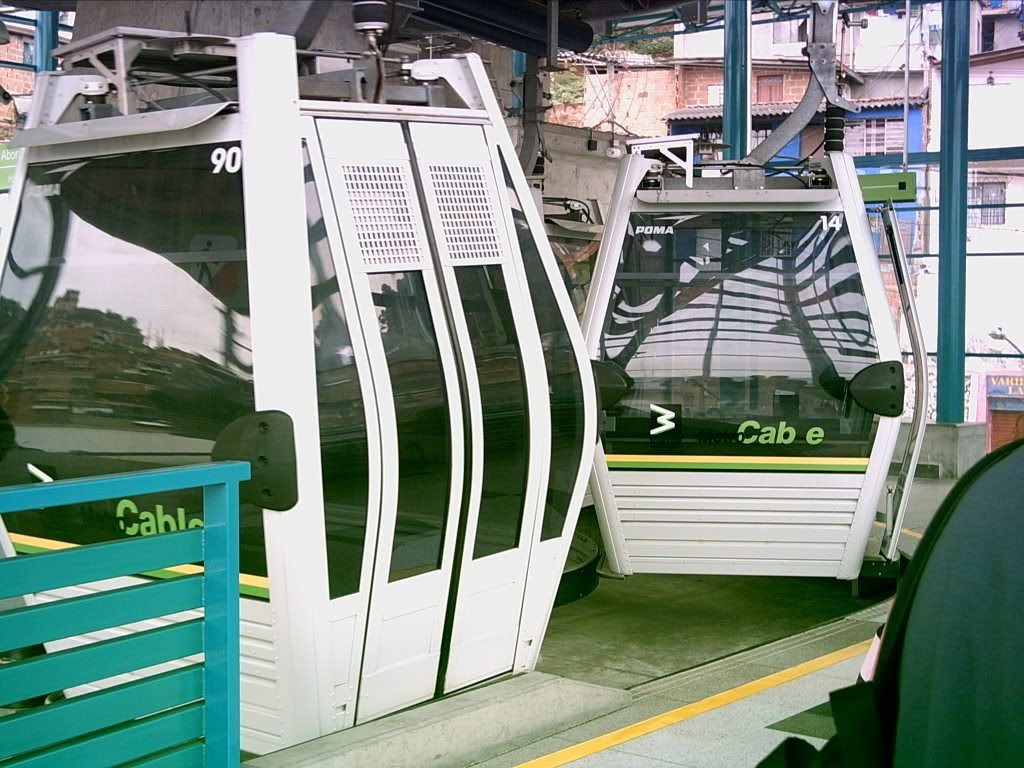Sunday, January 07, 2007
A truly ambitious project
Chavez's government is by now very well known for its massive public works projects. Yet as much as it has built it seems to add to what it wants to construct even more. The Caracas is Metro is a perfect example. It seems every few weeks a new map is released with even more components added to it. Here is the latest edition:

Parts of the transit system already built are in solid lines. What remains to be built is indicated with broken lines.
This map confirms some changes to the system. For example, the yellow line on top is the number 6 line which would parrellel the orange number 1 line which is hopelessly overcrowded. This line hadn't been on most recent maps but by it being included here it shows the government intends to build it. That is good news as they certainly need it.
It also shows how the number 2 line is now in part (the part in red) diverted through newly built stations to go directly to Plaza Venezuela. The final connection was made just this past week and this should help a significant number of people avoid the most overcrowded part of the 1 line, the part between Plaza Venezuela and Capitolio. That is certainly a welcomed and needed improvement. And note the further extension of that line from Zona Rental to Parque del Este is already under construction.
While the planned line to El Hatillo has been known about for some time there are other new projects that I am seeing for the first time on this map. For example, the recently opened Metro line to Los Teques will be further expanded to go to San Antonia (the blue line on the bottome left of the map). A completely new line will go from El Valle north to San Jose. Also, the number 2 line will be connected to the number 3 line. That will make it possible to travel between places like El Valle and Antimano without ever having to go near the number one line.
It also shows new rail connections with trains (indicated by the IAFE symbol) to the east leaving from La Urbina on the yet to be constructed 6 line and trains to the airport on the coast leaving from the number 1 line's Gato Negro station.
What is even more interesting are the thin lines off the Metro system with a gondola cabin in a circle. Those will be gondolas (similar to those used in ski areas) to make access to hillside barrios easier. I had heard rumors of this being considered but didn't think it was serious. From this, it clearly is serious. If fact, from the map it seems they intend to build nine of these gondola systems.
This diagram gives more information on these systems:

As can be seen, these systems will be up to two miles in length and will have a vertical gain of almost a thousand feet (can you imagine hiking up 1,000 feet to your home everyday?). They will have intermediate stations that will allow people to get off at various points. The other thing that is interesting is that they are quite economical to construct averageing about $25 million. Note that one gondola already is in service - the one that goes up El Avila mountain to a hotel and recreational area. According to the new Metro map that system will be extended down the north side of El Avila to reach the beaches on the Carribean Sea (there once was such a system and the abandoned towers can easily be seen on the north side of El Avila).
As has been pointed out before on this blog this is not a novel transportion system. It is already in use in Medellin Colombia where a "Metrocable" system has been built up a mountain side and have been proven to be quite popular.

Note that in this picture you can see one of the intermediate stations (with the curved white roof) and you then seen the gondola continue down the mountain at a different angle to a station at the bottom which is also where it connects with the Medellin Metro system. Presumabely the Caracas system will work the same way.




Here is a news report showing the system in action:
One very interesting point made by the reporter is that this system has increased peoples pride in their neighborhood and has led them to few their barrio as more permanent and desireable. This in turn has led them to invest in upgrading their homes and making other improvements in their community. Thus this is a proven system with some important ancillary benefits.
All of these projects will certainly take a decade or more to complete. But once done, wow, what a world class transportation system the residents of Caracas will enjoy. There are exciting times ahead for Venezuela's capital.
|

Parts of the transit system already built are in solid lines. What remains to be built is indicated with broken lines.
This map confirms some changes to the system. For example, the yellow line on top is the number 6 line which would parrellel the orange number 1 line which is hopelessly overcrowded. This line hadn't been on most recent maps but by it being included here it shows the government intends to build it. That is good news as they certainly need it.
It also shows how the number 2 line is now in part (the part in red) diverted through newly built stations to go directly to Plaza Venezuela. The final connection was made just this past week and this should help a significant number of people avoid the most overcrowded part of the 1 line, the part between Plaza Venezuela and Capitolio. That is certainly a welcomed and needed improvement. And note the further extension of that line from Zona Rental to Parque del Este is already under construction.
While the planned line to El Hatillo has been known about for some time there are other new projects that I am seeing for the first time on this map. For example, the recently opened Metro line to Los Teques will be further expanded to go to San Antonia (the blue line on the bottome left of the map). A completely new line will go from El Valle north to San Jose. Also, the number 2 line will be connected to the number 3 line. That will make it possible to travel between places like El Valle and Antimano without ever having to go near the number one line.
It also shows new rail connections with trains (indicated by the IAFE symbol) to the east leaving from La Urbina on the yet to be constructed 6 line and trains to the airport on the coast leaving from the number 1 line's Gato Negro station.
What is even more interesting are the thin lines off the Metro system with a gondola cabin in a circle. Those will be gondolas (similar to those used in ski areas) to make access to hillside barrios easier. I had heard rumors of this being considered but didn't think it was serious. From this, it clearly is serious. If fact, from the map it seems they intend to build nine of these gondola systems.
This diagram gives more information on these systems:

As can be seen, these systems will be up to two miles in length and will have a vertical gain of almost a thousand feet (can you imagine hiking up 1,000 feet to your home everyday?). They will have intermediate stations that will allow people to get off at various points. The other thing that is interesting is that they are quite economical to construct averageing about $25 million. Note that one gondola already is in service - the one that goes up El Avila mountain to a hotel and recreational area. According to the new Metro map that system will be extended down the north side of El Avila to reach the beaches on the Carribean Sea (there once was such a system and the abandoned towers can easily be seen on the north side of El Avila).
As has been pointed out before on this blog this is not a novel transportion system. It is already in use in Medellin Colombia where a "Metrocable" system has been built up a mountain side and have been proven to be quite popular.

Note that in this picture you can see one of the intermediate stations (with the curved white roof) and you then seen the gondola continue down the mountain at a different angle to a station at the bottom which is also where it connects with the Medellin Metro system. Presumabely the Caracas system will work the same way.




Here is a news report showing the system in action:
One very interesting point made by the reporter is that this system has increased peoples pride in their neighborhood and has led them to few their barrio as more permanent and desireable. This in turn has led them to invest in upgrading their homes and making other improvements in their community. Thus this is a proven system with some important ancillary benefits.
All of these projects will certainly take a decade or more to complete. But once done, wow, what a world class transportation system the residents of Caracas will enjoy. There are exciting times ahead for Venezuela's capital.
|
